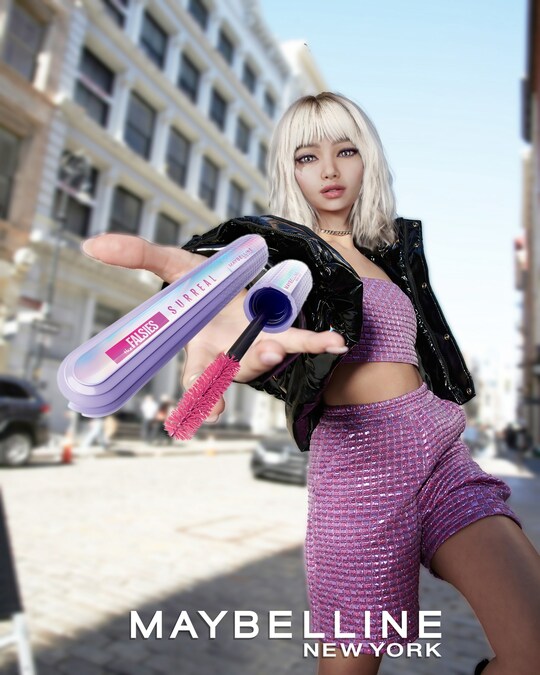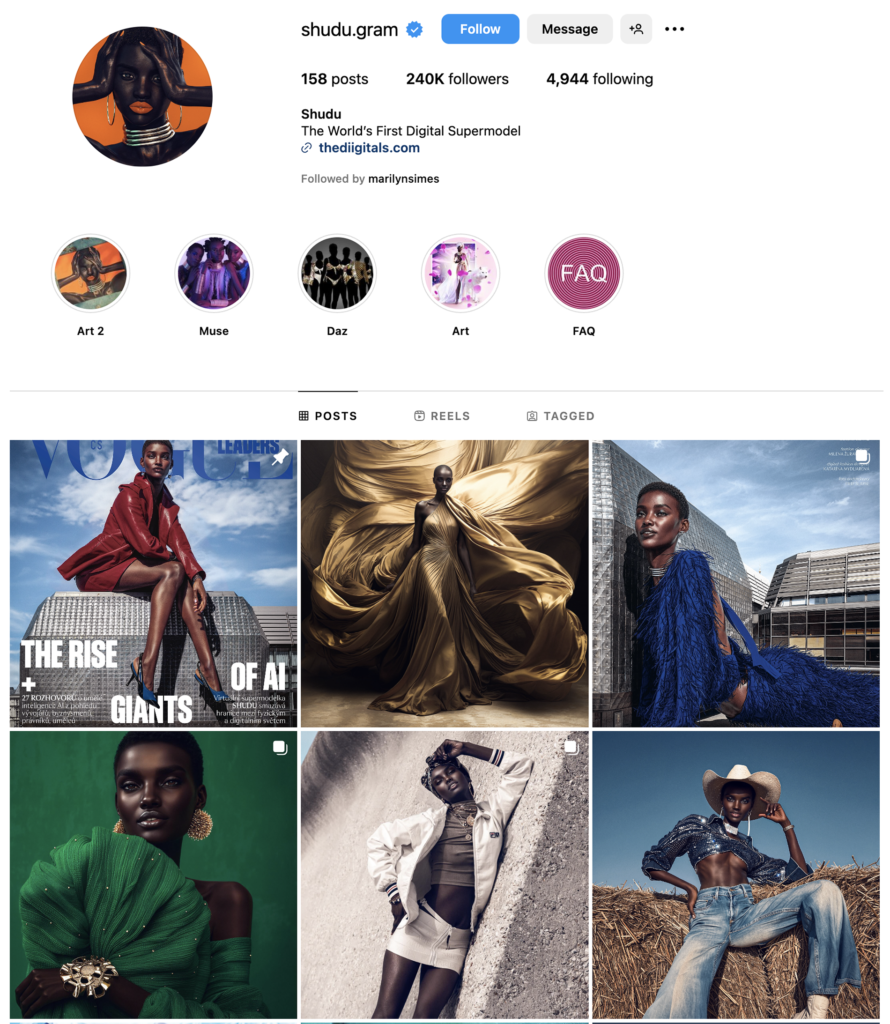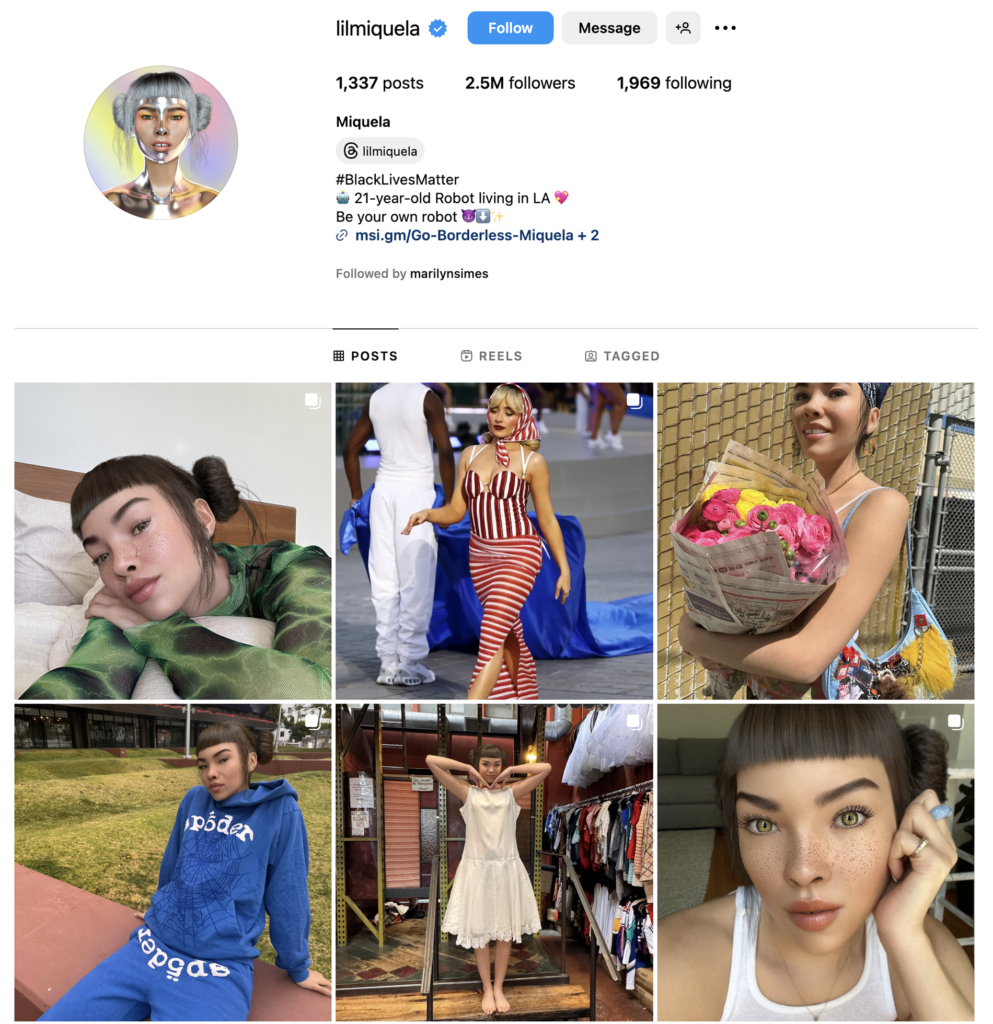The beauty industry is no stranger to innovation, and with the advent of AI technology, a new player has emerged on the scene: AI influencers. These virtual personas are not just a passing trend but are reshaping how brands interact with their audiences. At instinctsAI, we delve into the fascinating world of mega AI influencers and evaluate how they will affect their human counterparts. We will explore the benefits, challenges, and future implications for brands, agency partners, and consumers.
Maybelline New York Creates Two Heroines by Blending Real and Virtual Worlds for Falsies Surreal Extensions Mascara Launch

“Falsies Surreal Mascara Featuring Its First-Ever Avatar – May”
In 2022 and 2023, Digital Instincts collaborated with L’Oréal’s brand Maybelline New York on numerous digital brand launches, including product sampling for the launch and testing of the Falsies Surreal Extensions Mascara. Maybelline New York went on to expand the launch of its new Falsies Surreal Extensions Mascara by introducing its first-ever CGI-generated brand avatar, “May,” a cartoonish game-like character that appears in advertising alongside Maybelline’s global ambassador, Gigi Hadid.
May’s character enhances product brand themes and blurs the line between surreal and real-life worlds. This innovative approach created two brand heroines. May, a gamelike inspirational character, adds to the brand’s storytelling, and Gigi Hadid provides relatable substance to May’s character and credibility to the launch.
The Rise of AI Influencers
Influencer marketing has traditionally relied on real people, often celebrities, social media personalities, and everyday individuals with a substantial following, to promote products and brands. However, AI influencers are now gaining traction. According to a survey by Sprout Social in February 2024, 37% of consumers are more likely to be interested in brands that use AI influencers, rising to 46% among Gen Z’s. These AI-generated personas can be entirely fictional or based on real influencers who sell their likeness to brands.
The demand for AI influencers is increasing rapidly. In 2024, the global AI influencer market was projected to reach USD 6.95 billion, underscoring the growing investment and interest in this innovative marketing approach. Additionally, 52.8% of marketers believe virtual influencers will have a prominent impact on the future of marketing, further cementing their place in the industry.
Human Influencers vs. AI Bots: A Fine Line
The phenomenon of AI influencers is not just about creating new virtual personas. In some cases, brands use AI-generated images and videos of real influencers who sell their likenesses for promotional content. This can blur the lines between real and virtual, making it increasingly difficult for audiences to distinguish between them.
Kylie Jenner and AI Enhancements
Kylie Jenner has experimented with AI-generated enhancements to her promotional content. Using AI technology, brands have created lifelike digital versions of Jenner to model products and appear in marketing campaigns. This approach allows for consistent branding and extended reach without requiring Jenner’s physical presence for every shoot. The seamless integration of her digital likeness with real promotional content illustrates how AI can expand the influence of a human persona while maintaining a high level of engagement with audiences.
Lifestyle and Storytelling of New AI-Generated Influencers
Like Maybelline’s May character, a digital avatar is a computer-generated representation of a person or character used in digital contexts, such as virtual environments, social media, gaming, and virtual reality. These avatars can range from simple cartoonish representations to highly detailed, lifelike 3D models that mimic human appearance and behavior.
Beyond using the likenesses of real influencers, some brands are creating entirely new AI influencers. These AI Influencers have virtual personalities with unique backstories and distinct personas that resonate with specific target audiences.
Shudu is a humanlike notable AI fashion model

(Images:Instagram)
She was designed by professional photographer Cameron-James Wilson and first used to promote products for Fenty Beauty. She can be seen gracing the cover of Vogue magazine and is part of the Balmain Digital Army of CGI-generated Supermodels.
Future Outlook: Brands will continue experimenting with AI influencers, balancing the benefits of virtual personas with the authenticity and relatability of human influencers. The key to success will be finding a harmonious blend that leverages the strengths of both.
Aitana Lopez is an AI-generated Spanish influencer and fashion model

(Images:Instagram)
Aitana is a 25-year-old Spanish AI model with striking pink hair who quickly became a virtual sensation. She has over 320,000 Instagram followers and earns more than $10,000 monthly. Aitana’s blend of gaming, exercise, and cosplay content has made her a fascinating figure in the evolving landscape of influencer marketing. Her ability to blur the lines between art, fashion, and reality captivates audiences and demonstrates the potential of AI influencers to engage followers on multiple levels.
Lil Miquela, also known as Miquela Sousa, is an AI-generated influencer and model

(Images:Instagram)
She has hazel eyes, freckles, and a distinctive style. Miquela portrays the tastes and ways of a 19-year-old living in Los Angeles. She shares posts about learning Mandarin, driving, and her Brazilian heritage, blending personal anecdotes with social and political engagement. Her polished, poreless appearance and slightly unnatural hair movement highlight her CGI nature, yet she has amassed over 2.2 million Instagram followers and promotes brands like Calvin Klein and Prada. Miquela’s digital persona sparks debate about the line between reality and virtuality, engaging audiences with a mix of curiosity and speculation. Miquela recently signed with CAA (Creative Artists Agency) as their first virtual client.
Conclusion
As brands explore the potential of AI-generated influencers, models, and digital avatars, it’s essential to weigh the benefits and drawbacks of this innovative marketing approach. Integrating AI influencers into a marketing strategy should be guided by a brand’s agency, its instincts, and its understanding of its audience. Ultimately, the choice hinges on whether these virtual personas align with the brand’s identity, values, and marketing goals. By carefully considering AI influencers’ unique advantages and possible limitations, brands can determine if this new face of influencer marketing is the right fit for them.
KEY BENEFITS:
- Consistency: AI influencers can maintain a consistent online presence without the limitations of human schedules.
- Scalability: Virtual influencers can interact with followers 24/7, providing continuous engagement.
- Cost-Effective: AI influencers can be more cost-effective over time than high-profile human influencers.
- Creative Freedom: Brands can design AI influencers with specific traits, aesthetics, and values that align perfectly with their brand identity.
Adaptability: AI influencers can be easily reprogrammed to adapt to new trends, feedback, and market changes.
CHALLENGES:
- Authenticity: Audiences value genuine interactions, and AI influencers can lack the authenticity that human influencers provide.
- Ethical Concerns: Using real influencers’ likenesses raises ethical and legal questions about consent, representation, and compensation.
- Trust Issues: Some consumers may be skeptical of interacting with virtual personas, feeling they lack the genuine connection real influencers offer.
Content Saturation: The novelty may wear off as more brands adopt AI influencers, leading to content saturation and reduced engagement.
By leveraging the strengths of both human and AI influencers, brands can create dynamic and engaging campaigns that resonate with modern audiences. AI influencers will continue to diversify, with some becoming highly niche-specific while others appeal to broader audiences. The evolution of AI technology will enable these virtual personalities to become even more lifelike and engaging. At Digital Instincts, we’re excited to help brands navigate this new frontier, driving innovation and growth in leveraging and blending the art of both AI-generated and human influencers.
Stay tuned to instinctsAI for more insights into how AI is shaping the future of marketing. Contact us today for personalized AI strategies and solutions tailored to your brand!
Explore how our innovative solutions are reshaping industries by reading more about our case studies
This article was developed with the assistance of AI tools, including ChatGPT-3.5 and CoPilot, to aid in research and content structuring. While AI helped frame the concepts, the idea and origination of the story came from the author. The final content reflects the author’s perspective and experience.

